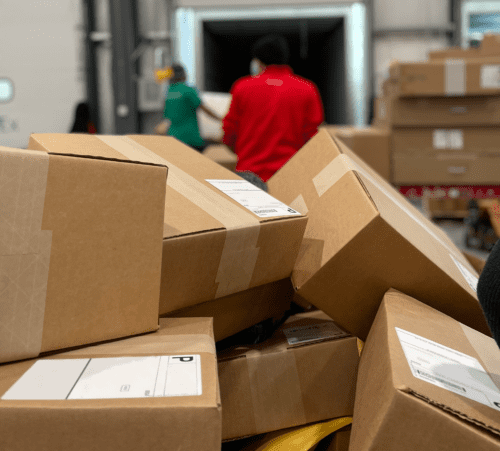Modern eCommerce businesses like yours are turning to inventory outsourcing to take back control and rekindle the joy of chasing a sale. When inventory gets in the way of a small business and eats up resources at every level, it’s time to expand beyond your own warehouse. Not only does that help you optimize goods sold, but you get to refocus on the customer that makes businesses like yours thrive.
You’ll need more than just inventory management software to help you address customer demands or determine if you’re carrying too much inventory. Outsourced inventory management options can be your secret to unlocking the potential of your business while you focus on the areas where you shine.
You deserve every chance to reduce management distractions that impact your ability to sell. If you’re struggling to keep up with physical inventory for your retail business, are unsure if you have too little or too much inventory, or just don’t like how much money is tied up in the warehouse, it’s time to consider outsourcing inventory management.

An honest approach to self-fulfillment and inventory outsourcing
Self-fulfilling your orders is the most common starting point for eCommerce businesses, and it often continues as you grow to a mid-size operation. You most likely started as a solopreneur and slowly added sales, inventory, and support teams. You’ve probably got some freelancers doing design and website work, while you focus on sales, marketing, and product development.
On those amazing weeks where customers are beating down the doors to order, you’re pitching in to grab items. Instead of changing ads, you’re packing boxes, and making extra trips to the nearby FedEx or UPS store. Maybe you’ve got a warehouse space and enough volume to have a carrier bring a trailer to you once a week.

And then you hit a wall…
For most companies, this works well until it doesn’t, and then things really break. That can look like orders pilling up and going out late. Or maybe goods are damaged because you don’t have the time and space to store them. An illness or family emergency reduces your headcount and then there aren’t enough hands to get the work done. Any or all of that can break your fulfillment, leading to unhappy customers. In turn, you get high returns, refund requests, and people shopping elsewhere next time.
This is when does inventory outsourcing starts to make sense
Of course, the goal is to switch away from practices before they reach the breaking point and start doing damage. In the fulfillment space, this means making a change at the first signs of risk. Plus, the sooner you shift the sooner you can get back to working on elements you love like sales and finding the next product. Those core competencies are where you grow and outsourcing the rest can reduce costs and save money.
Outsourcing fulfillment is designed to take this stress off of you. So, you’ll want to pay attention for those warning signs. While the specifics will look a little different for each business, there are five big dangers in inventory management, inventory costs, future demand, and fulfillment operations. Here’s what to watch for to avoid fulfillment becoming an issue.
1. Inventory management is getting too complex
Let’s start with some common pain points that signal an inventory management issue. See if you answer “yes” to:

- Are you facing mounting storage fees or consistent stockouts?
- Is your support team getting a lot of angry customers?
- Does your website have unexpected backorders?
- Are inbound shipments taking too long to get to your location, and then even longer to get on the shelf so that you’re missing sales?
- Would you struggle to accurately list what’s in stock right now?
We’ve designed outsourced inventory management to use order data, historical information, and current trends to help you restock as needed. Accurate item counts — always ask for guaranteed inventory accuracy — ensure you order what you need by reducing human error risks.
Inventory management is tough, and a breakdown will impact both immediate and long-term profitability. This is especially risky if you must order raw materials as well as finished products. Two core reasons to consider fulfillment and inventory outsourcing are missing sales because shelves are empty, or if you’ve invested too much in the wrong SKUs instead of top sellers. Professionals can give you a plan to tackle both, with plans specifically addressing your unique needs.
2. Inventory costs are hard to track

How much does your best-selling item cost you to store? What about those big-ticket items that sell more slowly but for a higher cost? In many cases, slow-moving inventory comes with higher storage costs because they sit on shelves for longer periods. Yes, the high sales price is a great boon for your bank account. But there’s a strong chance your margins are lower because of added costs around storage, moving items on shelves, stock counts, and more.
Outsourced inventory management and fulfillment helps you avoid these concerns in two ways. First, detailed analytics and dashboards can give you a complete cost analysis. You know how much that product costs from the moment it arrives to when it leaves the warehouse. This way, you get an accurate picture of total cost and might see when smaller, but faster-moving items give you a better return. And who doesn’t want to focus on sales with higher ROI?
Second, turning over fulfillment to experts helps avoid damage and harm to these goods — the risk increases the longer it sits in your own facility. This protects your investment and reduces the chance of surprise stockouts.
So, you understand the return on every SKU to invest your capital better, while also having professional benefits that protect goods throughout warehousing and storage processes.
3. You’re unsure if inventory forecasting is accurate

Warehouse and product costs increase when you order too much or too little. You’re either storing things and moving them too often or you end up needing to expedite inbound freight and shipments to customers as soon as something is back in stock.
Companies like yours can reduce costs through outsourcing when you struggle to get inventory counts right. You’ll want robust analytics and forecasting based on your sales over time, recent trends, and accurate information on how long it takes to get and process inventory from the time you place a purchase order from your manufacturing partners. This tracking can be complex to do on your own, but it’s one of many important aspects of sales.
Adding third-party logistics partners like Red Stag can help you look deeper into data and create more accurate forecasts. That way, you have the goods customers want while avoiding those long-term inventory costs. Reliable data from a reliable partner leads to smarter decisions. You’re giving your team the best chance to get it right and delight customers.
4. SKUs are stacked too high to use

How many items get damaged in your facility each month just due to storage issues? What does that cost your business in terms of resources and customer loss?
The issue is simple in many smaller eCommerce warehouses, but the solution is tough. You could just be stacking too many boxes on a pallet, putting heavy items on lightweight units, or unloading in a hurry so package pyramids are a mix of SKUs. In these cases, products are stacked in ways that make them difficult to use. That can be something too time-consuming to sift through, damaging products and boxes so you can’t sell them, or hiding units so you restock too soon and are wasting money.
You waste money unnecessarily when your team doesn’t have the time, space, or expertise to stack goods so that they’re usable and safe. Inventory outsourcing to a professional 3PL solves these issues starting on day one.
5. It’s unclear how to grow next

Many eCommerce companies have one final concern: they can scale sales and marketing but aren’t sure how operations need to expand to accommodate this growth. What happens when your warehouse gets in the way?
This is one of the big areas that you solve through inventory outsourcing and order fulfillment help. You’re facing management distractions at the fulfillment and warehouse level while maintaining control of core business functions. You’re a master at the sales and development of your business. Order delays, carrier contracts, delays at rail yards and ports, and so on, can all get in the way of your success.
Turn to a fulfillment expert to get help with everything from old inventory and new finished goods to scaling teams and processes that ensure you’re always on time and accurate. Trust an expert to give you the blueprint to success.
How long does it take inventory outsourcing to help?
Perhaps the most important question for you to ask when you’ve decided to look at outsourced inventory management is how long it will take for them to give you the first benefit. Follow that up by asking how long they’ll maintain these advantages for your business.
Inventory management outsourcing services will have a slow on-ramp with significant long-term gains. Red Stag can take 30 days or more to fully onboard you and start filling orders. But our processes are designed to start delivering immediate accuracy improvements while cost reductions per order slowly mount over the lifetime of our relationship. That means the longer you’re working with us, not only do you get improved inventory forecasting support but more considerable warehouse savings potential.










